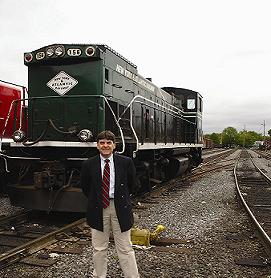The new acting President of the New York & Atlantic Railway is Mark H. Westerfield. He lives in Glendale, a few blocks from NY&A’s Fresh Pond Yard, and walks to and from work every day. He has a daughter, son-in-law and grandson, all of whom he is extremely proud, in Gurnee, IL. Mark greatly enjoys NYC’s diverse neighborhoods and has seen many of them “up close and personal” as he is an avid runner and covers much of the territory around Queens and Brooklyn on a daily basis.
Mark Westerfield began his railroad career as a switchman on the Milwaukee Road, in Aberdeen, South Dakota, while he was a freshman at Northern State University. Westerfield is a fourth generation railroader. Upon graduation from college, Westerfield moved to Chicago and took his first management job as a “trainmaster” at Milwaukee’s Bensenville Yard.
Like so many U.S. railroads, the Milwaukee Road no longer exists. It filed for bankruptcy in December of 1977 and was taken over by the Soo Line in February of 1985, which in turn, disappeared into the Canadian Pacific a few years later.
Westerfield left the Soo/Milwaukee in November of 1985 and has worked on and started several short line or feeder railroads across the U.S. and Canada. His career includes a brief stint as Director of Planning and Route Evaluation for Amtrak in Chicago, and 5 years with the Union Pacific, also in Chicago.
Mr. Westerfield has put together a brief history of the freight rail delivery system in the boroughs of Brooklyn and Queens to provide us with some background so that we may better understand the future of rail freight movement as we move further into the 21st century. With the exception of the Hempstead, Port Washington, Oyster Bay and Atlantic Avenue branches, the NY&A operates on all lines owned by the LIRR. The NY&A has exclusive rights on the Bushwick Branch (4 miles) and the Bay Ridge Line (11.5 miles). Both lines diverge from the LIRR Lower Montauk Line at Fresh Pond Junction.
Fresh Pond Junction constitutes the line’s main yard and was the historic junction between the LIRR and numerous carriers that preceded the NY&A. The line from Fresh Pond Junction to the Brooklyn waterfront at 65th Street and Second Avenue was originally constructed as the New York, Bay Ridge & Jamaica Railroad, and later was known as the New York, Brooklyn & Manhattan Beach Railroad. Almost from its inception, it was leased to the LIRR and formally merged into that line in 1925.
With the construction of the New York Connecting Railroad, a joint venture of the New Haven & Pennsylvania Railroad, which began in 1912, the line was extended from Fresh Pond Junction to the Bronx, via the Hell Gate Bridge. At its height, the line boasted 4 main tracks from Fresh Pond Junction to 65th Street, and was electrified between 1927 and 1968. The Penn Central merger saw a dramatic decrease in traffic and elimination of electrification.
The NY&A’s main interchange partner is CSX, which delivers and pulls cars from Fresh Pond Junction 7 days a week. CSX crews operate to and from Oak Point Yard in the Bronx. The Canadian Pacific Railroad also has trackage rights on this route, tri-weekly. Providence & Worcester crews deliver trains of crushed stone, two or three days a week on a seasonal basis. In addition, the NY&A connects with a car float operated by the New York – New Jersey Railroad at the 65th Street Yard at the end of the Bay Ridge Branch. This route has seen
considerable growth in recent years. New York – New Jersey serves as bridge carrier for the Norfolk Southern Railway. This interchange is usually accomplished on a Monday thru Friday basis.
The NY&A began operation in May of 1997 and has enjoyed a steady increase in traffic, from 9,000 cars per year at its outset to over 22,000 cars last year. Commodities handled include: lumber, beer, rice, fresh vegetables, paper, plastic pellets, brick, edible oils and propane arriving inbound, with significant amounts of construction & demolition debris, scrap metal, and a smaller amount of municipal solid waste heading outbound. Add scrap metal, and it is over 2,000 cars a year!
It is worth noting that in the shade of a more than 100-year old tree at Fresh Pond Junction rests the site of the NY&A’s offices and locomotive shop. Care was exercised to save the tree as the new office and shop were constructed. Saving this tree was indicative of NY&A’s understanding of the value of preserving nature and improving air quality. And, air quality will definitely improve as we use our voice to advocate for the removal of municipal solid waste by sealed rail cars and eliminate the hundreds of 18-wheeler waste haulers that plow through our neighborhoods every night and weekend. In addition to improved air quality we must advocate through the proper authorities to get the float bridge at 65th street in operation forthwith and to build a new float bridge at the Greenville Yards in New Jersey. The operation of new reliable float bridges will provide a significant increase in the amount of rail cars moved across New York Harbor each year, reduce truck traffic on Hudson River crossings and reduce congestion on the BQE and the LIE.
As we learn more about the value of moving freight by rail, NY&A is indeed an important neighbor in addressing the problems of air quality, unwanted truck traffic and road congestion and is lucky to have someone as knowledgeable as Mark Westerfield as its acting President.




